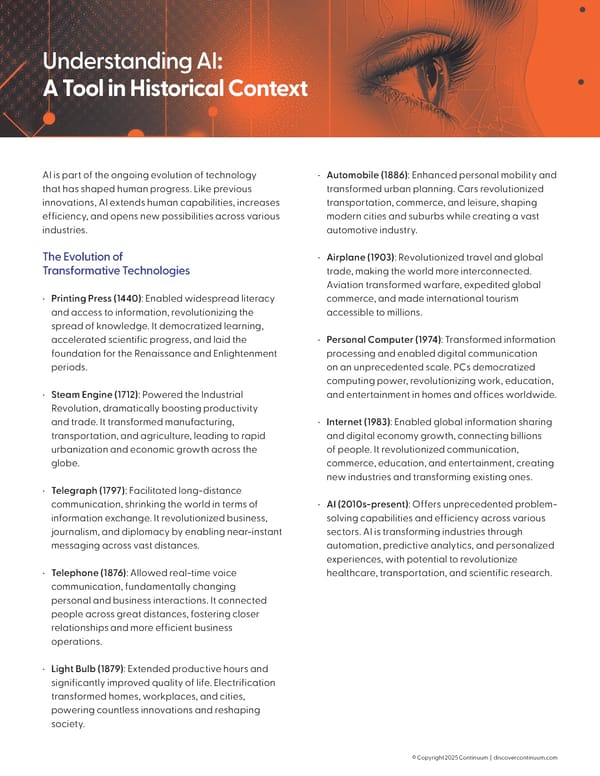Understanding AI: A Tool in Historical Context AI is part of the ongoing evolution of technology • Automobile (1886): Enhanced personal mobility and that has shaped human progress. Like previous transformed urban planning. Cars revolutionized innovations, AI extends human capabilities, increases transportation, commerce, and leisure, shaping efficiency, and opens new possibilities across various modern cities and suburbs while creating a vast industries. automotive industry. The Evolution of • Airplane (1903): Revolutionized travel and global Transformative Technologies trade, making the world more interconnected. Aviation transformed warfare, expedited global • Printing Press (1440): Enabled widespread literacy commerce, and made international tourism and access to information, revolutionizing the accessible to millions. spread of knowledge. It democratized learning, accelerated scientific progress, and laid the • Personal Computer (1974): Transformed information foundation for the Renaissance and Enlightenment processing and enabled digital communication periods. on an unprecedented scale. PCs democratized computing power, revolutionizing work, education, • Steam Engine (1712): Powered the Industrial and entertainment in homes and offices worldwide. Revolution, dramatically boosting productivity and trade. It transformed manufacturing, • Internet (1983): Enabled global information sharing transportation, and agriculture, leading to rapid and digital economy growth, connecting billions urbanization and economic growth across the of people. It revolutionized communication, globe. commerce, education, and entertainment, creating new industries and transforming existing ones. • Telegraph (1797): Facilitated long-distance communication, shrinking the world in terms of • AI (2010s-present): Offers unprecedented problem- information exchange. It revolutionized business, solving capabilities and efficiency across various journalism, and diplomacy by enabling near-instant sectors. AI is transforming industries through messaging across vast distances. automation, predictive analytics, and personalized experiences, with potential to revolutionize • Telephone (1876): Allowed real-time voice healthcare, transportation, and scientific research. communication, fundamentally changing personal and business interactions. It connected people across great distances, fostering closer relationships and more efficient business operations. • Light Bulb (1879): Extended productive hours and significantly improved quality of life. Electrification transformed homes, workplaces, and cities, powering countless innovations and reshaping society. © Copyright 2025 Continuum | discovercontinuum.com
 AI for Business: A Comprehensive Guide to Boosting Efficiency and Innovation Page 3 Page 5
AI for Business: A Comprehensive Guide to Boosting Efficiency and Innovation Page 3 Page 5